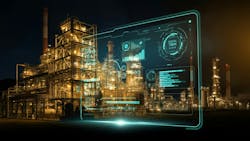Energy Saver: AI + Automation Closes the Waste-Detection Loop
In a 2023 report, McKinsey showed artificial intelligence in manufacturing could deliver $4.4 trillion in productivity growth potential, and 94% of chemical industry leaders consider AI critical to success. With all the hype around AI for efficiency, it’s important to remember AI doesn’t save energy by itself: closed-loop action does.
The chemical industry is seeing a rapid evolution from rule-based automation to AI-enhanced autonomous systems. Innovations include self-adaptive algorithms for real-time process optimization and AI-driven digital twins that promise to achieve unprecedented accuracy in process replication. Automation, and in particular robotic systems, put AI’s insights to work every hour of every shift.
The Leakage We Live With
Plants can lose double-digit percentages of useful energy to avoidable defects that operations teams know exist but struggle to catch consistently. For example, compressed air leaks could historically waste 20%–30% of compressor output. Steam trap failure rates in unmanaged systems are commonly estimated to be 8%–15% and heat exchanger fouling erodes recovery. Addressing these opportunities is not a one-time project, they require a new operating model where robots, fixed sensors, and AI-driven analytics are integrated and serve as a standards-based maintenance crew.
Why Robotics Now: Maturity, Safety and Standards
Three trends should inform your outlook on robotics. First, industrial AI has matured from dashboards to prescriptive analytics embedded in control and maintenance workflows. Second, intrinsically safer and standards-compliant robotic platforms can repeatedly scan hot, noisy or hazardous areas with thermal, acoustic and gas sensors. This expands the frequency and fidelity of inspections without adding risk.
Recent advances include autonomous gas-leak detection systems with 360° acoustic imaging that can detect and quantify various gas leaks including steam, compressed air and hydrocarbons. Third, integration frameworks like ISA 95 and ISO 50001 enable energy-performance improvements to be governed, measured and verified across sites. This helps scale pilot wins into enterprise results.
Energy Implications
So how do you navigate the link to energy efficiency? Start where physics and cost merge. Modern solutions can reduce utility energy consumption by up to 10% and associated carbon emissions by up to 40%. These systems represent a significant advancement over traditional rule-based automation.
In compressed air systems, autonomous acoustic technology can continuously map leak rates by zone. This, in turn, should lead to informed repair campaigns, which have been shown to deliver 20%–30% reductions in compressor output.
In steam systems, thermal and acoustic sensors can verify trap operation under load, cutting steam losses when paired with a repair plan. The U.S. Department of Energy guidance has long shown significant savings when inspection and repair are institutionalized, yet modern wireless acoustic monitoring can now provide continuous trap monitoring rather than periodic inspections.
For fired heaters and heat exchangers, AI-assisted monitoring of approach temperatures and pressure drop can trigger cleaning at the economically optimal point, improving heat recovery and lowering fuel intensity. Model predictive control (MPC) on furnaces and distillation columns adds a further step change, with additional economic benefits and energy reductions when managed tightly. Wrapped in an ISO 50001:2018/Amd 1:2024 management system, which incorporates climate action changes, these measures commonly yield persistent portfolio savings in the low double digits.
Guidance for Implementation
Measurement matters. Start by establishing an energy-performance baseline tied to production, ideally using ISO 50001 principles. Plan the verification approach up front using International Performance Measurement and Verification Protocol, so savings are credible and auditable. Select one to two high-yield use cases per asset class, such as compressed air leak abatement and steam trap management, then instrument routes with robots and fixed sensors to cover all operating modes.
Close the loop by integrating detections with the computerized maintenance management system, assigning work orders with standard job plans and tracking mean time to repair so leak and trap backlogs shrink rather than cycle.
Additionally, integrate and maintain ISA-95/IEC 62264 standards, which addresses modern IT/OT convergence, containerized workloads and data-centric architectures. Even with all the standards, change management requires senior-management involvement, risk-assessment requirements and improved energy performance indicators. This approach is toward industrial digitalization where operational technology and information technology converge.
As your confidence grows, layer on control-side optimization, starting with model predictive control on the best-behaved unit, then scale by pattern. Throughout the implementation and execution, it’s important to keep cybersecurity hygiene aligned to industrial control systems guidance and keep safety governance current with robot safety.
Energy efficiency in chemical processing is now an operations capability, not a capital bet. AI plus robotics turn once a year audits into everyday action, and when grounded in ISO 50001 with disciplined measurement and verification, the savings persist, compound and scale.
References
Chui, M., Hazan, E., Roberts, R., Singla, A., Smaje, K., Sukharevsky, A., Yee, L. and Zemmel, R. (2023) 'The economic potential of generative AI: The next productivity frontier', McKinsey & Company, 13 June.
Efficiency Valuation Organization. (2012). International Performance Measurement and Verification Protocol: Concepts and options for determining energy and water savings, Volume I. EVO.
IEA (2017), Digitalisation and Energy, IEA, Paris https://www.iea.org/reports/digitalisation-and-energy, Licence: CC BY 4.0
International Electrotechnical Commission (IEC). (2013). IEC 62264-1:2013: Enterprise-control system integration – Part 1: Models and terminology (2nd ed.). IEC.
International Organization for Standardization. (2018). ISO 50001:2018 Energy management systems—Requirements with guidance for use. ISO.
International Society of Automation (ISA). (2025). ANSI/ISA-95.00.01-2025: Enterprise-control system integration – Part 1: Models and terminology. ISA.
ISO 10218 1:2011. (2011). Robots and robotic devices—Safety requirements for industrial robots—Part 1: Robots. International Organization for Standardization.
NIST SP 800-82 Rev. 3. (2023). Guide to Operational Technology (OT) Security. National Institute of Standards and Technology.
Mayer, H., Yee, L., Chui, M., Roberts, R. (2025) ‘Superagency in the workplace: Empowering people to unlock AI’s full potential’, McKinsey & Company, 28 January.
Qin, S.J. and Badgwell, T.A., (2003). A survey of industrial model predictive control technology. Control engineering practice, 11(7), pp.733-764.
Schneider Electric. (2024). From goals to results: ISO 50001 fosters sustainable success. Schneider Electric Blog, September 17.
Schneider Electric. (2024). Industrial artificial intelligence: Optimizing energy efficiency with predictive AI, November 29. Schneider Electric Blog.
Singla, A., Sukharevsky, A., Yee, L., and Chui, M. (2025) 'The state of AI: How organizations are rewiring to capture value', McKinsey & Company, 11 March.
Therkelsen, P., & McKane, A. (2013). Implementation and evaluation of ISO 50001 at industrial facilities in the United States. Lawrence Berkeley National Laboratory.
U.S. Department of Energy. (2006). Steam tip sheet 17: Inspect and repair steam traps. Office of Energy Efficiency and Renewable Energy.
U.S. Department of Energy. (2010). Operations & maintenance best practices: A guide to achieving reliable performance (Release 3.0). Office of Energy Efficiency and Renewable Energy.
U.S. Department of Energy, & Compressed Air Challenge. (2009). Improving compressed air system performance: A sourcebook for industry (2nd ed.). Office of Energy Efficiency and Renewable Energy.
About the Author
Thomas Kwan
Global Vice President, Strategic Innovation and Industrial Ecosystems
Thomas Alan Kwan is an energy transition expert at Schneider Electric's Sustainability Research Institute. With a Ph.D. in chemical and environmental engineering, he brings a blend of academic rigor and industrial experience to the field of sustainable manufacturing and green engineering.
At Schneider Electric, he leads initiatives focused on new and emerging industrial systems, with a particular emphasis on the chemical processing sector. His work involves developing innovative solutions and practices to drive energy, environmental and economic benefits.
Previously, he was a key member of Unilever's product engineering team, where he integrated green chemistry and engineering principles for product and process development. His contributions earned him a lifetime honorary membership on the team. Kwan also has experience in environmental regulation, having worked with the U.S. EPA on Clean Water Act programs.
Through his research and collaborations, Kwan continues to explore innovative ways to reduce energy consumption, minimize waste, maximize value and improve overall process efficiency in chemical manufacturing operations.

